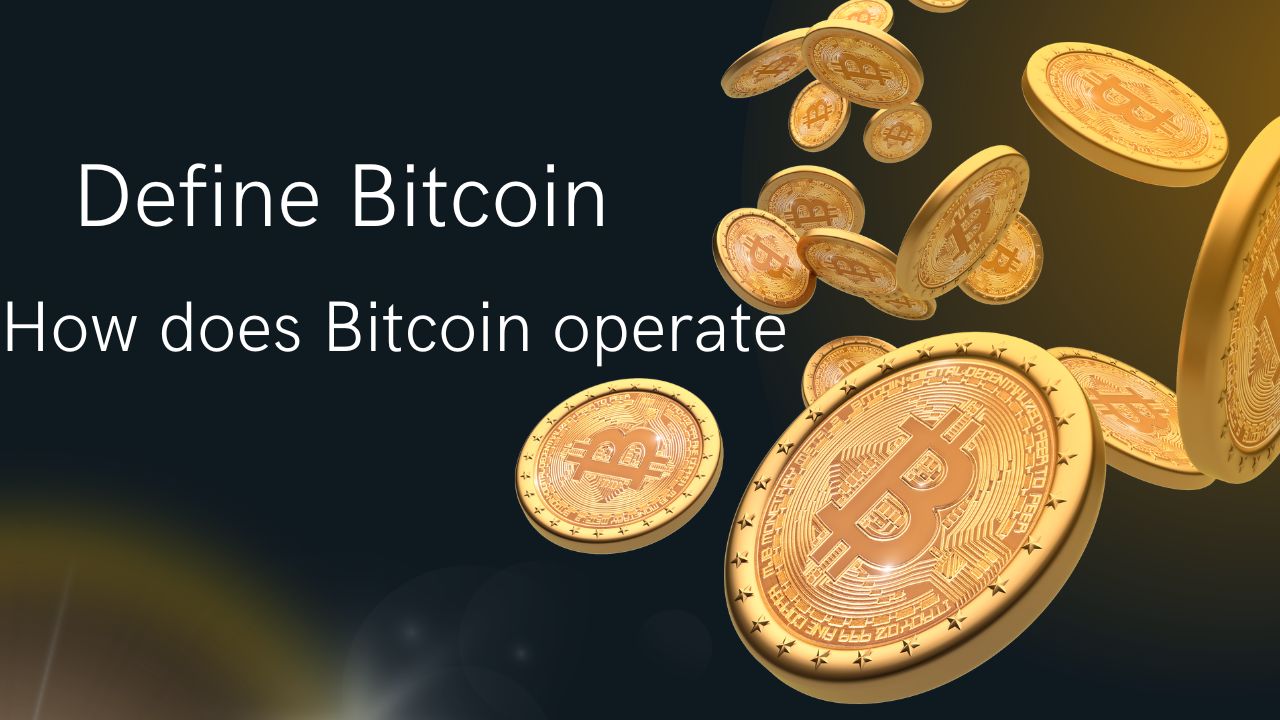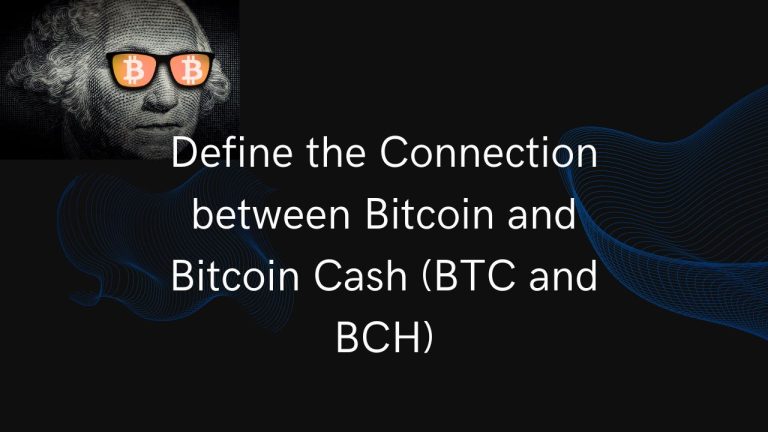Define Bitcoin and how Bitcoin operates
Introduction:
Bitcoin is a form of digital currency that operates independently from any form of centralized administration, bank oversight, or governmental control. It substitutes peer-to-peer software and cryptography.
A public ledger, containing copies of every Bitcoin transaction, is kept on servers all over the world and serves as the record of every Bitcoin transaction.
What serves as the foundation for Bitcoin, and how does it operate?
Bitcoin is not backed by a government or issued by a central bank like conventional currencies are. Because of this, Bitcoin is not affected by variables like inflation, monetary policy, and economic growth indicators that frequently affect the value of currencies.
The basis of Bitcoin is a distributed digital ledger known as a blockchain. A network of interconnected data called a “blockchain” is what is meant by the term “blockchain.” It is made up of units called “blocks” that each contain information about a single transaction, including the buyer and seller, the time and date, the total amount, and a unique identification code for each trade. The entries constitute a temporally related chain of blocks.
After being added to the blockchain and made publicly viewable, a block serves as a public record of cryptocurrency transactions. The blockchain is decentralized, thus it is not under the jurisdiction of a single entity. A Google Doc that is available for editing is how the digital blockchain works. Anyone with a link may change it, albeit it is not particularly controlled by anyone. It is updated as numerous others, including you, make improvements to it.
The ability for anyone to alter the blockchain may appear perilous, yet this is precisely what makes Bitcoin dependable and secure. The majority of Bitcoin miners must confirm a transaction block before it can be added to the network.
To identify users’ wallets and transactions, the proper encryption technique must be combined with the unique codes required. It is incredibly difficult to copy these unique codes because they are long random integers. Because the blockchain verification codes required for each transaction are statistically random, the likelihood that a fraudulent Bitcoin transaction will be made by anyone connected to the network is significantly decreased.
Exactly why was Bitcoin made?
In the 19th and 20th centuries, several of the most popular currencies could be exchanged for fixed amounts of gold or other precious metals. However, the bulk of countries abandoned the gold standard between the 1920s and the 1970s, in part due to the challenges of financing two world wars and the failure of global gold output to keep up with economic development.
In the past, tangible items like silver and gold were also traded for products and services. However, because they were cumbersome to carry and prone to loss and theft, banks retained physical assets for users and produced notes verifying users’ bank holdings.
Customers rely on banks to maintain the worth of their money and protect their assets. But between 2008 and 2009, numerous banks and other financial organizations went bankrupt, prompting government bailouts financed by taxpayers.
The collapse of the banks, which were responsible for guarding public monies, highlighted how susceptible the current financial system may be and the need to decentralize financial services to enhance the customer experience. One common misconception about Bitcoin is that it was created in response to the Great Banking Crisis and the financial sector’s reliance on banks to function as middlemen in financial transactions.
Satoshi Nakamoto came up with the idea to do away with the need for banks to be involved in every financial transaction by replacing them with a peer-to-peer (P2P) payment system that didn’t require third-party confirmation. Bitcoin and other cryptocurrencies are built on the blockchain, a decentralized ledger.
What year did Bitcoin start, then?
On January 3, 2009, the first block known as the genesis block was mined, launching the blockchain in its official capacity. A week after that, the initial test transaction took place. Only Bitcoin miners who were validating transactions had access to the blockchain for the first several months of the currency’s existence.
Bitcoin did not yet have any real financial worth. Miners, the machines that employ challenging mathematics to find new Bitcoin and verify that existing Bitcoin transactions are accurate and valid, would trade Bitcoin as a form of amusement.
When a Florida guy agreed to trade 10,000 Bitcoin for two $25 Papa John’s pizza deliveries on May 22, 2010, that was the first business deal ever conducted. This day has been designated as Bitcoin Pizza Day ever since.
When did Bitcoin get started?
In the wake of the 2008 financial crisis, a person or group of people going by the pseudonym Satoshi Nakamoto published a white paper that served as the inspiration for the invention of Bitcoin. The financial crisis was a significant factor in the rise of Bitcoin. To give readers a quick summary of Bitcoin’s history, creators, and intended applications, this article will attempt to provide those answers.
The housing market collapse during the global financial crisis of 2007 and 2008, also known as the subprime mortgage crisis, caused a large reduction in liquidity in international financial markets (which started in the United States).
As the world descended into a global recession brought on by excessive financial market speculation and banks risking millions of dollars in depositor funds, the white paper laid the groundwork for the first fully operational digital currency based on the blockchain, or distributed ledger technology (DLT). Then, what is Bitcoin and how does it work?
The Bitcoin white paper was the first to outline the fundamentals of a cryptographically secure trustless peer-to-peer (P2P) electronic payment system that was primarily created to be censorship-resistant, transparent, and to give individuals back their financial power.
Digital currency or cryptocurrency, such as Bitcoin operates decentralized from any central authority.
A cryptocurrency is a kind of digital money that employs encryption to secure and validate transactions. By converting plain text into ciphertext, a meaningless or random text, encryption is the process of doing this. The study of secure communication techniques, such as encryption, that prohibit recipients and other parties from reading messages sent to them, is known as cryptography.
To compete with today’s fiat money and perhaps someday become a global unit of account, bitcoin was created. Nowadays, fiat currencies like the US dollar and the British pound are the most widely utilized types of money. Fiat currencies are those that are controlled by and maintained by a national government, which regulates their issuance and supply.
Bitcoin, on the other hand, uses peer-to-peer technology to enable transactions between parties that believe the asset being transferred has inherent worth. P2P refers to the direct exchange of a resource, such as Bitcoin, between individuals without the involvement of a centralized authority.
Public and private keys are the building blocks of Bitcoin.
At its foundation, Bitcoin is a decentralized public-key cryptosystem that facilitates peer-to-peer digital value exchange through a series of digitally signed transactions rather than messages. A series of encrypted communications that follow a similar fundamental process flow to a Bitcoin transaction is depicted in a diagram of public-key cryptography and digital signatures.
Public-key cryptography secures data from unauthorized access or use by encrypting and decrypting it using a set of keys. A digital signature, also known as an electronic signature, is a means of confirming the truthfulness and integrity of a digital message using a mathematical process. In light of this, Bitcoin is a network of digital signatures.

Each owner can transmit Bitcoin to the next by digitally signing a hash of the previous transaction and the new owner’s public key and then affixing them to the end of the coin. Through a review of the signatures, the payee can verify the ownership chain.
The related public and private keys must be available to users to transmit the needed amount of Bitcoin. When someone says they possess Bitcoin, they mean that they have access to a key pair, which consists of both public and private keys.
A public key is an address that has already received some Bitcoin. Once Bitcoin is sent to the aforementioned public key, it can then be sent elsewhere by utilizing the special private key that comes with it (a password) (address).
Bitcoin addresses, also known as public keys, are alphanumeric sequences of arbitrary length that work a lot like email addresses or social network usernames. Since they are public, as their name implies, users can safely share them with others. In reality, users must divulge their Bitcoin address to everyone they want to send them Bitcoin.
The private key is composed of a unique set of alphabetic and numeric characters created at random. Private keys ought to be kept private, just as passwords for email or other services. Never share your private key with someone you don’t fully trust.
Inputs and outputs for transactions
A separate transfer for each penny would be unfeasible even though it is possible to handle coins one at a time. Transactions’ many inputs and outputs make it possible to split and combine value.
There are typically simply two outputs: one for the payment and one for sending the sender any leftover change. Either a single input from a previously larger transaction or a combination of numerous smaller inputs will be used as the input.
At this moment, imagine Romeo wants to send Juliet 1 BTC. He accomplishes this by signing a message that contains transaction-specific information with his private key.
The inputs hold details on the Bitcoin that was previously transmitted to Romeo’s address. Consider the case where Alice gave Romeo 0.7 Bitcoin and Bob gave Romeo 0.7 Bitcoin. To send 1 BTC to Juliet, two inputs might be required: one 0.7 BTC input from Alice and one 0.7 BTC input from Bob.
Romeo wants to send a total of 1 BTC Outputs: The first output is delivered to Juliet’s public address and contains 1.4 BTC (0.7 BTC + 0.7 BTC). Romeo receives a “change” of 0.4 BTC in the second output.
Broadcasting and network confirmations
In the prior example, Romeo will utilize his wallet program to inform the Bitcoin network of his intended transaction. Verifying the inputs (i.e., the address(es) from which Romeo previously received the Bitcoin he claims to possess) is done by a certain class of network users known as “miners”.
Miners also aggregate a list of other transactions that were broadcast to the network around the same time as Mark’s to create a block. A new block can be “attached” to the chain by any miner who has completed the proof-of-work, or PoW, by citing the previous block. The network is then informed about the new block.
whether additional new actions contained therein are compliant with all protocol standards and properly reference the preceding block. As soon as the users (nodes) of the earlier block agree that it is a valid block, they will pass it (i.e., the trunk when proposing the following block) to another miner who will afterward build upon it by designating it. The subsequent miner will have “verified” any transactions that were contained in the prior block. The number of confirmations for Romeo’s transaction grows as new blocks are added to the chain.
Define Bitcoin mining and how it takes a job.
The process of adding new transactions to the Bitcoin blockchain is known as mining. It’s a difficult job. In the Proof-of-Work (PoW) algorithm, computers compete to find solutions to puzzles that validate transactions. Producing a hash, which is a 64-digit hexadecimal number, that is less than or equal to the target hash is the aim of mining.
The projected number of hashes generated by miners to solve the current Bitcoin block or any particular block is indicated by the term “Bitcoin hash rate.”
Bitcoin’s hash rate is expressed in hashes per second or H/s. To successfully mine, a miner needs a high hash rate, which is expressed in mega hashes per second (MH/s), gigahashes per second (GH/s), and terahashes per second (TH/s).
As an incentive to keep trying to crack the codes and maintain the network, the Bitcoin code rewards miners with extra Bitcoin. In this manner, the system gains new blockchain transactions.
It’s crucial to realize that the speed of each block’s solution has nothing to do with the hash rate of Bitcoin. The Bitcoin mining difficulty value, which is modified upwards or downwards at each block, determines the block time, which is the time at which blocks are resolved.
Since bitcoin mining is no longer as profitable as it once was, it is much more challenging to recoup the extra costs associated with purchasing computational power and using it to conduct a mining operation while using electricity.
Every time a miner acquired more Bitcoin than they do currently, they were given a stamp when the system was first put into place in 2009. The block award is divided in half every 210,000 blocks (roughly every four years).
One block, for instance, cost 50 BTC when Bitcoin was originally mined in 2009. This fell to 25 BTC in 2012. To 12.5 BTC by 2016, it has been further cut in half. The award was once more reduced to 6.25 BTC on May 11, 2020.
As transaction volume increases, the amount that miners are paid per stamp decreases. Since it’s expected that all of Bitcoin will be in use by the year 2140, miners will have no choice but to rely on transaction fees to make money from validating the network.
How does a Bitcoin wallet operate and what is it?
The storage of Bitcoin as well as other cryptocurrencies like Ethereum is possible using a digital wallet called a Bitcoin wallet (ETH). A Bitcoin wallet is a type of digital wallet that stores the encryption key that provides access to a BTC public address and authorizes transactions (or any other crypto wallet). Hardware, paper, web, desktop, and mobile wallets are among the five basic types of Bitcoin storage.
In addition to holding your digital currency, bitcoin wallets also safeguard it with a unique private key that can only be accessed by you and anybody else you give the access code to. A crypto wallet allows you to store, send, and receive a variety of coins and tokens. While some only deal with simple transactions, others have built-in access to decentralized apps (DApps) powered by blockchain technology.
When you establish a Bitcoin wallet, you will be given both a private key and a public key. When you establish a Bitcoin wallet, you will be given both a private key and a public key.
A public key is like an email address in that anyone can use it. When you create your wallet, a public key is generated that you may use to accept payments from anyone.
A public key is similar to an email address in that it may be shared with anyone. When your wallet is set up, a public key is generated that you can use to accept payments from anyone.
How can I purchase and sell Bitcoin and What is a Bitcoin exchange
A Bitcoin exchange is an online market where users can buy and sell bitcoins (BTC) using different fiat currencies and alternative cryptocurrencies. A Bitcoin exchange is a website that serves as a go-between for buyers and sellers of BTC.
Similar to a regular stock exchange, traders can buy and sell Bitcoin using either a market order or a limit order. A user must register with the exchange and go through several identification verification procedures before they may trade Bitcoin on an exchange. After successful authentication, the user’s account is formed and they must put funds into it before they may purchase or trade BTC.
How private is Bitcoin?
Since it may be transmitted and received without disclosing any personally identifiable information, bitcoin is frequently referred to as “anonymous.” However, using BTC can make it challenging to maintain a certain level of anonymity, and it can even be impossible.
Bitcoin transactions are akin to anonymous email. Everything a writer has ever written under a pseudonym will also be associated with them if their real name is ever connected to it.
The address where you receive Bitcoin in Bitcoin is your pseudonym. The blockchain maintains a record of every transaction involving an address. If your address is ever matched to your identity, then every transaction will be associated with you. Bitcoin is therefore pseudonymous rather than anonymous.
Bitcoin’s benefits and drawbacks
Bitcoin’s benefits
The Bitcoin network is ungoverned. Every member of the Bitcoin network implicitly guarantees that the protocol will function. Users of Bitcoin have significantly greater control over their personal information and financial data than users of fiat currencies and other types of digital payment methods like credit cards when compared to conventional financial infrastructures. They also have less identity theft risk than people who utilize fiat currency and other types of digital payment methods, such as credit cards.
Identity theft occurs when criminals have adequate knowledge about a person’s identity, such as that person’s name, current or prior residence, or birthdate. Due to cryptographic private keys, which conceal a user’s identity behind a Bitcoin wallet address that is visible to the general public, the risk of identity theft when utilizing crypto is low.
The network hash rate of Bitcoin, which measures the total amount of computing power used to validate transactions on the blockchain at any given time, is constantly breaking records.
To protect the shared truth of the blockchain record, the Bitcoin blockchain is growing more resilient to a 51% attack. The possibility of a 51% attack still exists despite the thankfully improved network security. When one or more miners control more than 50% of the computing, mining, or hashing power of a network, this is known as a 51% assault. If it is successful, the in-charge miners will be in charge of the network and some of its transactions.
A 51% attack would give miners the power to obstruct the recording of new transactions, prevent them from being validated or completed, change the order in which transactions are processed, prevent other miners from mining coins or tokens within the network, and reverse transactions to double-spend money.
For instance, in a double-spend scenario, miners may buy something with cryptocurrency and then undo it later. It indicates that by keeping the items they bought as well as the bitcoin used in the transaction, miners rob the seller. However, as a blockchain grows in size, malevolent miners find it more difficult to attack it. On the other side, smaller networks may be more vulnerable to a blocked attack.

The drawbacks of Bitcoin
The governments may try to restrict, regulate, or make the purchase and sale of Bitcoin illegal, as certain jurisdictions have in the past. For many traders who are concerned about the probable price decline of the currency, the ongoing media emphasis on Bitcoin’s volatility serves as another significant disincentive. Unfortunately, people are still using Bitcoin to fund illegal operations including money laundering. Conversely, clandestine groups around the globe are enhancing their cybersecurity and anti-crypto crime capabilities.
The inability to undo Bitcoin transactions is not necessarily a good thing. In the event of an assault, a failed transaction, or a false exchange of goods, it can quickly become a significant issue.
Anything electronic must be reversible, according to a fundamental premise of contemporary finance. If Bitcoin is truly the internet applied to money, it should also feature a “back” button. Fraud can only be avoided if there isn’t an undo or back button. However, once it is recognized that anything suspicious happened and addressed, fraud can be stopped, allowing it to be identified and reduced.
In contrast, a BTC theft requires the private key for a thief to steal $1,000,000 worth of Bitcoin from a company. There is no way to recover Bitcoin if it is taken by hackers because transfers of BTC balances are permanent. The Bitcoin wallet’s password is likewise irrecoverable, so if a user forgets it, the money in his wallet is useless.
The Prospects for Bitcoin
For the development of Bitcoin, the next ten years could be crucial. Beyond changes in the value of Bitcoin, investors need to pay special attention to a few other aspects of the environment. At the moment, cryptocurrencies can be used as both a store of value and a transactional medium.
Institutional investors are eager to get in on the action and profit from the volatility in its pricing, although governments around the world, including Japan, have acknowledged it as a viable method of payment for products.
Nevertheless, scale and security difficulties have prevented both occasions from becoming the ideal medium of trade. Security issues, custody issues, and capital efficiency issues are still a concern that requires attention.
FAQS:
Is Bitcoin truly currency?
Bitcoin is referred to as a “digital currency” and “an alternative to central bank-controlled fiat money” (BTCUSD). Nevertheless, the latter is valuable since it is created by a monetary authority and widely used in an economy.
Can Bitcoin be converted into cash?
There are two main ways to convert Bitcoin into cash and then send it to a bank account. The first option is to employ an outside exchange broker. Your bitcoins will be converted into cash at a predetermined rate by these third parties (which also include Bitcoin ATMs and debit cards). It is both easy and safe.
What is Bitcoin in plain English?
A cryptocurrency, virtual currency, or digital currency are all terms that are used to describe Bitcoin, a completely virtual form of money. It looks like the equivalent of virtual cash. Although hardly any shops anymore accept Bitcoin, and some countries have openly banned it, you can use it to buy products and services.
What is Bitcoin’s purpose?
To facilitate online money transfers, Bitcoin was created. The idea behind digital money was to provide an alternative payment method that worked similarly to traditional currencies elsewhere and did not require centralized control.







